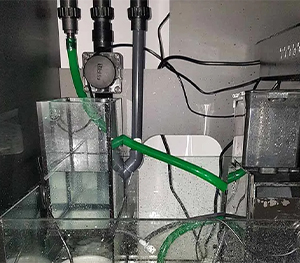Tuning a bean animal overflow is easy … once you see how it’s done.
While there is a ton of info online about setting up a bean animal overflow. And a lot of written info about how to get it dialed in.
But it’s MUCH easier to understand what is meant by ‘properly dialed in’ when you can actually see one running.
The problem is a lack of videos showing what properly, and improperly, tuned bean animal looks like.
Watch the following videos and you’ll see just how easy tuning a bean animal overflow can be.
Given the incredible volume of information that’s already available online about assembling a bean animal overflow, I won’t go into any detail on it in this post.
If you do need info on setting one up, I recommend starting with this Bean Animal Overflow thread on ReefCentral.com. It’s a VERY long read, but it’s packed full of information.

Now, let’s get ready to tune that overflow.
Disclosure: This article contains affiliate links. When you follow a link to purchase the products, I sometime earn a commission, at no additional cost to you. Read my full disclosure here.
There Are Three Methods of Tuning a Bean Animal Overflow
The first way to tune the flow of a bean animal is by using the valve on your siphon line.
Gate valves are more expensive than ball valves but they are also MUCH easier to make fine adjustment to. That’s why experienced bean animal users HIGHLY recommend spend the extra money on a gate valve. Ball valves will work but take a VERY gentle and patient hand to adjust. (Turning the handle 1/16″ on a ball valve increases flow much more than on it does on a gate valve.)
The second is by adjusting the flow control on your DC return pump … if you have one.
The third is by adjusting the valve on you siphon line until you get the flow close to ‘perfect’, then using the flow control on your DC return pump to ‘fine tune’ it.
A DC return pump is NOT required for using or tuning a bean animal overflow.
All that is needed is that valve on your siphon line.
Time to start tuning!
Close your valve all the way, then open it up 1/4 of the way.
Turn on your return pump and watch flow in your overflow box.
Your Bean Animal is ‘Under’ Tuned If It Looks Like This:
An under-tuned bean animal. The valve needs to be opened more.
In this situation it is flowing too slow.
Open the valve a little bit at a time until the siphon pipe is flowing without any gurgling or bubbles coming out of it … AND just small trickle of water is running down your open channel pipe. It should be almost silent.
Your Bean Animal is ‘Over’ Tuned If It Looks Like This:
An over-tuned bean animal. The valve needs to be closed more.
In this case it is flowing too fast.
Close the valve a little bit at a time, until the siphon pipe is flowing without any gurgling or bubbles coming out of it … AND just small trickle of water is almost silently running down your open channel pipe.
You’ve Tuned Your Bean Animal Jud Looks Like This:
A well-tuned bean animal. Just one or two ‘gurgle cycles’ at start-up. Then, within a few minutes, it stabilizes and maintains a consistent water level in the overflow box.
Notice how, after just 2-3 minutes, the water level remains even about 1/4 of the way up horizontal section of the middle pipe – which is the open channel pipe on this setup.
Once you’ve got it dialed it in, it’s time to test it…
Shut off your return pump. Wait a few minutes until no more water is draining down your sump. Then turn you return pump back on.
After one or two major gurgling cycles, you BA overflow should stabilize and run steady just like in the video.
If it did, congratulations! You’re done tuning your bean animal overflow and have it dialed in right where it should be.
If not, don’t worry, you’re very, very close…
Fine Tune It
If it takes too long to stabilize, just fine tune it very gently a bit more … using the tiniest of turns to your valve … the same as described above. The slightest tap to the valve handle is all it may take. Be gentle and patient with each adjustment — we’re talking a 1/16″ of an inch or less in some instances.
And if you do have a DC return pump, this is where it can come in handy. Making fine adjustments on the pump controller may be easier than making them with the siphon valve.
Once it’s running with a fine trickle down the ‘trickle’ pipe, test it once more just to make sure it starts up, stabilizes quickly, and flows just the way you want it.
When it comes to overflows, nothing beats a bean animal set-up for safety, reliability, capacity, or silence.
You’ve made a great choice in using one. And now that you can tune it, it’ll be one of the most worry-free parts of your set up.



